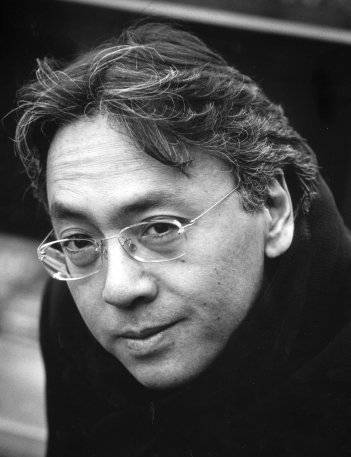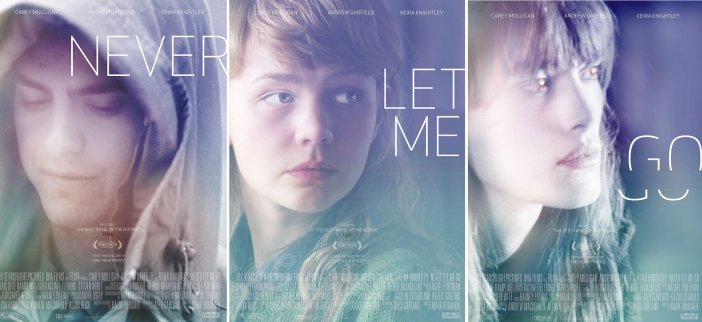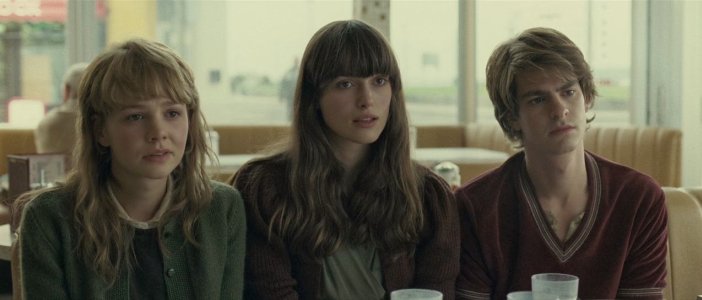Literature on Film | 13 | Analysis on the Adaptation of Kazuo Ishiguro’s Never Let Me Go
Warning – Spoiler for both novel and adaptation of Never Let Me Go
“I keep thinking about this river somewhere, with the water moving really fast. And these two people in the water, trying to hold onto each other, holding on as hard as they can, but in the end it’s just too much. The current’s too strong. They’ve got to let go, drift apart. That’s how it is with us. It’s a shame, Kath, because we’ve loved each other all our lives. But in the end, we can’t stay together forever.”

One of the reasons why Kazuo Ishiguro’s science-fiction novel Never Let Me Go is so interesting is because it’s not really a sci-fi novel at all. It boasts the premise of a YA novel – in an alternative vision of the past, society has perfected the cure for cancer. Clones are created and raised in boarding schools separated from the rest of humanity. When these clones reach the peak of their lives, they are harvested for their healthy vital organs. Yet, the British-Japanese writer approaches this story in the same way he would any of his other dramas centred in reality (eg The Remains of the Day). The sci-fi elements are slowly teased throughout the novel, but the real thrust of the story comes from the love triangle at its centre. Within Hailsham, a school for clones, the strong and self-sufficient protagonist (who narrates the novel in first person) Kathy H. is in love with Tommy. However, he, from an early age, is romantically involved with Kathy’s best friend, the popular but needy Ruth.
As a result, Never Let Me Go is a novel which plays with genre convention. It’s science fiction with none of the story beats of one. Details which would be vital in a typical sci-fi (why wouldn’t the children escape) are explained away in one or two lines. Meanwhile, the melancholia of a doomed relationship occupies paragraphs, such as the one beginning this article. The sci-fi backdrop plays the same role that social constraints do in The Remains of the Day: it’s a plot device that keeps two potential lovers apart.

These are the type of details that can be misinterpreted in a film adaptation. A screenwriter could potentially find the sci-fi element more intriguing than the love triangle. To an extent, this occurs in the 2010 movie based on the novel, directed by Mark Romanek (One Hour Photo) and written by Alex Garland (Ex Machina). Garland is a writer critically acclaimed for his work in SF such as his scripts for 28 Days Later, Sunshine and Dredd, as well as his novel The Coma. He removes some of the more human elements of Ishiguro’s opening section (Ruth and Kathy’s feud over a pencil-case, Kathy’s dream to be a mother), while retaining almost all of the fantastical elements, as well as adding some more (barcodes on the clones’ wrists, regular medical check-ups). Garland also reveals the story’s twist far earlier on in the story than Ishiguro. As a result, the film is fifty per cent SF, and fifty per cent drama. That’s still less sci-fi than most films of the genre, but noticeably more for those who have read the book. As a result, the movie slightly undercuts the brilliant character development one gains from the more realist early sections of Ishiguro’s novel.
That said, director Mark Romanek and cinematographer Adam Kimmel (Capote) manage to capture on-screen the visuals and atmosphere of the book beautifully. The idyllic hallways and gardens of Hailsham, the isolation of the country-side cottages where the clones live pre-donation, the iciness of the hospital operating rooms: these settings are portrayed exactly as they were written in the novel. Romanek is quoted as stating:
“I toyed around with filming some futuristic buildings … but it never felt right. I wanted to make a love story.”
This was clever as what makes Ishiguro’s story and Romanek’s subsequent adaptation feel so poignant and emotional is its familiarity. If Romanek had added a futuristic landscape, the events of the story would be interpreted as dystopian and therefore, not as close and as relevant to the viewer’s world. Ishiguro’s descriptions of locations, “misty lanes”, “narrow twisting lanes”, “open featureless country-sides”, are evocative in their mundanity, their everyday-ness. Thus, a futuristic setting would have made Romanek’s adaption feel unnecessarily foreign and alienating.

Although, Garland seems more interested in the sci-fi elements of the story, his script is ambitious in the sense that it manages to fit every major plot-point of Ishiguro’s 282-page novel into a ninety-seven-minute film. Often his abridging works to the movie’s favour, creating a more propulsive narrative than Ishiguro’s. For instance, Kathy and Ruth’s eventual falling out in the book was the result of a minor spat which was the final straw in a culmination of ongoing conflicts:
“I suppose, there were powerful tides tugging us apart by then, and it only needed something like that to finish the task”.
However, Garland’s script has the two (played by Carey Mulligan and Keira Knightley) become estranged more explicitly over jealousy surrounding Tommy (Andrew Garfield). In one climactic scene, not in the novel but using certain dialogue from other sections, we see Ruth ominously towering above Kathy, threatening her over her feelings for Tommy as she lays in bed. It’s a thrilling scene which not only makes Ruth more interesting than her two-dimensional literary counterpart, it elevates the film breathlessly into an area akin to that of horror. Also, it dispels any notion put forth by a certain Irish director that Knightley is less an actress than a model (see below).
[youtube id=”apwQjKurlSY” align=”center” autoplay=”no” maxwidth=”750"]
Another example of Garland’s speedy run-through of Ishiguro’s events benefitting the story is the restaurant scene. This is when the trio venture out in public to eat, accompanied by the slightly older, more experienced clones Chrissie and Rodney (Andrea Riseborough and Domhnall Gleeson). In the novel, Chrissie and Rodney, are minor characters who are not very well-rounded. The couple appear briefly, having not been brought up in Hailsham, and serve only two functions. They symbolise in their banter and actions what an ideal romantic relationship looks like (contrasting with Ruth and Tommy) while also propelling the plot with their discussion of “deferrals”. This is a rumour spread amongst clone couples that they can have their donations postponed if they can prove to a Hailsham guardian that they are truly in love.

Garland wisely cuts many of Chrissie and Rodney’s scenes in order to place a greater emphasis on their most important moment. This is when the couple ask the trio whether the rumours of deferrals are true. Perhaps, it’s down to Riseborough and Gleeson’s scene stealing and tremendously emotive performances, but seeing the two’s warm smiles and attitudes mutate to faces of confusion and desperate pleas as Tommy replies “I don’t know what you’re talking about” is more devastating on-screen. Also, in the novel, by the end of the day, Chrissie and Rodney appear to have gotten over their frustration, with Rodney urging the gang to visit a friend of his who is “a real laugh”. In the film, we never see the duo again, creating the impression that their lives are hopeless and that they will never recover from having their dream dashed.
However, in trying to cram so much plot into a relatively short film for today’s standards, some threads feel under-cooked. For instance, the section of the novel that I found the most emotionally affecting was the brief period, following a dying Ruth’s insistence, that Kathy looks after the weak Tommy (following two operations). The two begin a love affair that is literally marked for death. As Kathy states:
“There was something in Tommy’s manner that was tinged with sadness, that seemed to say: ‘Yes, we’re doing this now and I’m glad we’re doing this now. But what a pity we left it so late”.
This sense of a doomed romance is missing from the film as Garland once again turns his attention to the more sci-fi elements of the story. After waiting eighty minutes for Ruth and Tommy to get together, it’s a little infuriating to see Garland and Romanek spend eight minutes detailing the couple’s visit to seek a deferral from their old guardian at Hailsham (Charlotte Rampling). The elderly woman explains the truth regarding the deferral rumours and wraps up some minor mysteries regarding the actual science of cloning. Although Mulligan and Garfield are heart-breaking in the scene (particularly the latter capturing the animalistic and simplistic nature of Tommy within the book), the denouement lacks the emotional gut punch of the novel’s end. One can’t help but feel that the movie could have used another fifteen minutes to flesh out this vital portion of the story.
Featured Image Credit

